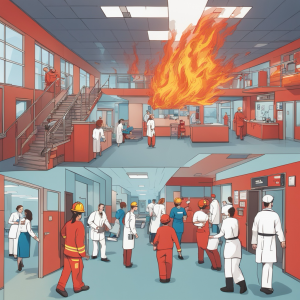
Fire safety is a critical component of risk management in healthcare facilities. Unlike most buildings, hospitals, nursing homes, and other medical centers present unique challenges in fire prevention and response due to the presence of vulnerable populations, specialized equipment, complex layouts, and continuous 24/7 operations. This makes robust fire safety planning not just necessary, but potentially life-saving. This article explores key fire safety considerations for healthcare facilities, including prevention strategies, regulatory compliance, emergency response protocols, and staff training.
- Understanding the Unique Challenges
Healthcare facilities differ significantly from other commercial or residential buildings in several key ways:- Vulnerable occupants: Patients may be immobile, unconscious, or reliant on life-support systems, making evacuation difficult.
- High occupancy levels: Hospitals often operate near full capacity, increasing the risk during emergencies.
- Complex infrastructure: Extensive wiring, oxygen systems, and other specialized medical equipment heighten the fire risk.
- 24/7 operations: Healthcare facilities never close, requiring fire safety protocols to function around the clock.
Understanding these challenges is the first step in developing effective fire safety measures.
- Fire Prevention Strategies
- Electrical System Maintenance
Many hospital fires are caused by electrical faults. Regular inspections, maintenance, and prompt repair of electrical systems are essential. Facilities should:- Use certified electricians familiar with healthcare settings.
- Conduct thermal imaging to detect overheating components.
- Avoid overloading circuits, especially in critical care areas.
- Safe Storage of Flammable Materials
Hospitals use a range of flammable substances, from cleaning agents to medical gases like oxygen and nitrous oxide. Fire safety depends on:- Proper labeling and storage of all flammable materials.
- Installing gas shut-off valves and ventilation in storage areas.
- Ensuring compliance with safety standards like NFPA 99 (Health Care Facilities Code).
- Fire-Resistant Construction and Materials
Healthcare buildings should incorporate fire-resistant materials in walls, ceilings, and flooring. Fire barriers and smoke partitions are essential to compartmentalize fire and prevent its spread.
- Electrical System Maintenance
- Fire Detection and Suppression Systems
- Fire Alarms and Smoke Detectors
An effective early warning system is vital. Healthcare facilities must:- Install a networked fire alarm system with both audible and visual alerts.
- Place smoke detectors in all patient rooms, hallways, and utility areas.
- Regularly test and maintain detection systems.
- Sprinkler Systems
Automatic sprinkler systems are a cornerstone of fire suppression. In healthcare settings:- Systems must be strategically placed to cover high-risk areas like kitchens and storage rooms.
- Water supply and pressure should be regularly checked.
- Alternative suppression methods (e.g., inert gas systems) may be needed in sensitive areas like data centers or MRI rooms.
- Fire Extinguishers
Facilities should be equipped with:- Easily accessible and clearly labeled fire extinguishers.
- Staff trained in identifying extinguisher types and using them safely.
- Regular inspections to ensure extinguishers are charged and in working condition.
- Fire Alarms and Smoke Detectors
- Evacuation Planning and Emergency Response
- Evacuation Procedures
Creating a realistic evacuation plan is critical. It should include:- Horizontal evacuation: Moving patients to adjacent smoke-free zones, especially important for immobile patients.
- Vertical evacuation: Used as a last resort; may involve stair chairs or stretchers if elevators are unsafe.
- Clearly marked and illuminated exit routes, even during power outages.
- Fire Drills and Simulations
Regular fire drills should:- Involve all staff, including night shifts.
- Include role-specific duties (e.g., who transports patients, who contacts fire services).
- Test various scenarios, including blocked exits or equipment failure.
- c. Coordination with Emergency Services
Hospitals should maintain strong relationships with local fire departments. This includes:- Sharing building plans and access routes.
- Participating in joint training exercises.
- Ensuring fire crews are familiar with on-site hazards and critical patient areas.
- Evacuation Procedures
- Regulatory Compliance and Standards
Healthcare facilities must comply with multiple fire safety regulations and codes, including:- National Fire Protection Association (NFPA) codes, especially:
- NFPA 101: Life Safety Code
- NFPA 99: Health Care Facilities Code
- Joint Commission standards, which assess fire safety as part of hospital accreditation.
- Local building and fire codes, which may vary by state or municipality.
Regular audits, both internal and external, help ensure compliance and identify areas for improvement.
- National Fire Protection Association (NFPA) codes, especially:
- Staff Training and Education
A well-informed staff can prevent fires and respond effectively in an emergency. Key training topics include:- Recognizing fire hazards and reporting protocols.
- Operating fire extinguishers (using the PASS technique: Pull, Aim, Squeeze, Sweep).
- Evacuation procedures and patient prioritization.
- Understanding the facility’s emergency communication system.
Continuing education, onboarding sessions for new employees, and periodic refresher courses are all essential.
- Technology and Innovation in Fire Safety
Modern technology is improving fire safety in healthcare:- Smart detectors can distinguish between smoke, steam, and dust, reducing false alarms.
- Integrated alarm systems can automatically notify emergency services and activate response protocols.
- Digital mapping and RFID tags can help locate patients and staff during evacuation.
- Fire modeling software can simulate fire scenarios and assist in designing safer facilities.
- Retrofitting Older Facilities
Many healthcare buildings are decades old and may not meet current fire safety standards. Retrofitting may involve:- Installing new sprinkler systems.
- Replacing outdated wiring.
- Upgrading fire doors and ventilation systems.
- Incorporating new egress routes or smoke compartments.
While costly, retrofitting is essential to ensure patient safety and legal compliance.
Conclusion
Fire safety in healthcare facilities is a multifaceted responsibility that encompasses prevention, detection, suppression, evacuation, compliance, and training. Given the high stakes involved — including the safety of patients, staff, and vital infrastructure — healthcare administrators must adopt a proactive and comprehensive approach to fire risk management. Through diligent planning, regular training, and adherence to evolving standards, healthcare facilities can ensure they are prepared to prevent, detect, and respond to fire emergencies swiftly and effectively.

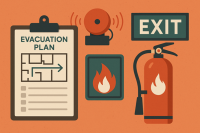
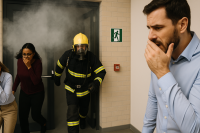
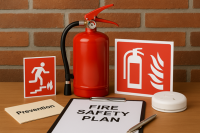
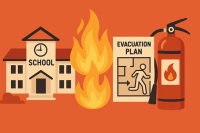
Leave A Comment